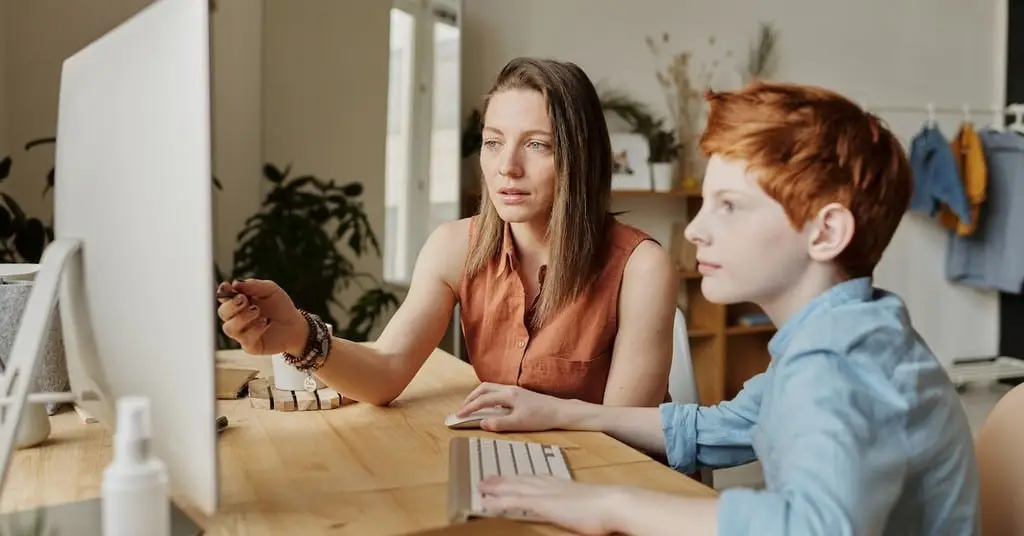In this article:
- Tips for designing an indoor learning environment
- Preventing accidents during physical activity
- Organization for kids to thrive in the home environment
- Creating places to display kids’ work and successes
- Creating a homeschooling schedule
Your child’s learning environment is crucial to their overall development. Children need access to comfortable, exciting learning spaces and sensory activities at every stage to thrive. That’s why when it comes time to enroll your child in school, you may wonder if homeschooling is a valid option.
Learning from home can be just as legitimate as learning in a classroom. With a little planning and imagination, you can transform your home into an ideal school environment where your child will be safe, comfortable, and motivated.
Designing an indoor homeschooling space means looking at your home a little differently. Is there enough space for physical education activities and active play indoors? What learning activities are available in your kitchen or garden that you can introduce as their teacher? Does your child have access to the learning materials they’ll need?
There are a few simple things you can do to transform the space you already have into an enriching learning environment for your child.
Tips for designing an indoor learning environment
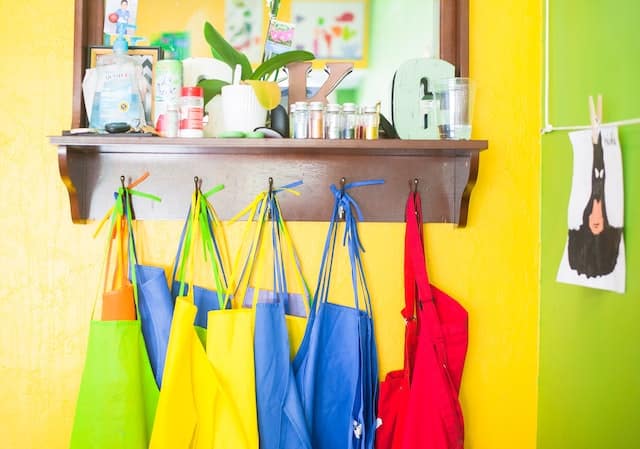
Home learning spaces influence children’s developmental stages, confidence, and behavior. The more comfortable your child feels, the more likely they are to focus and learn. To make your learning environment comfortable, pay attention to things like sounds, the flow of the space, visibility, and texture.
Sound
Music is engaging, interactive, and inspirational. You can use music in your lessons to keep your child motivated for working or relaxed for naptime and focus time. As your child gets older, encourage them to pick out songs for studying and dance breaks.
Some kids feel overwhelmed when there’s too much noise. If you have higher ceilings and bare floors, the acoustics in your home might be distracting. Strategically placing a few rugs can soften the noise, making the learning environment less stressful for your kid.
It’s essential to have some quiet zones available. Your child may need to withdraw for some quiet playtime or even a nap. Designating certain areas as quiet zones also helps children understand appropriate behaviors. They’ll be able to tell where they can be loud and active and which spaces are better for quiet time.
Movement
The flow of your home is about safety and ease. Look out for tripping hazards, sharp edges, or hard floors that need a rug. Your child should be able to crawl, walk, or run freely and safely in your home.
Just like you set aside space for music and noisy activities, set aside play areas where your child can make a mess and throw a few toys around. (Hint: the play area can be the same as the noisy music area.) Children enjoy having some freedom at playtime, and you can relax knowing you have the chaos under control even as their teacher.
Visibility
What can your child see in the learning environment? Can they see outside to the garden or backyard? If they’re sitting at a table or desk, can they see where all their learning materials are?
Consider your furniture setup. Is it easy for your child to settle in at a desk? Finding a spot for a drawing table or desk creates a clear space for learning. Make sure that toys, crayons, and learning materials are in clear containers so your little one can see what they need.
Smell and light
Natural light and fresh air will help your little one stay refreshed and alert. Artificial blue lights impact circadian rhythms, so limit screen time as your kid gets tech-savvy. Take away artificial light an hour before bed or naptime to optimize their rest.
When it comes to smell, open up windows and bring in some fresh flowers or herbs. These plants will add visual appeal and keep your home smelling sweet without being overwhelming like artificial air fresheners would be.
Use smell and light to keep your child engaged in science lessons. Herbs and gardening are great learning experiences for kids. Let them help collect herbs outside for cooking or drying, or let them tear up some fresh basil to add to their meal. Hold up a prism in front of a window and show children how to make rainbows.
Texture and color
Textures and colors are essential for interior design and encourage home education. Sensory play and exploring different textures promote language development, cognitive growth, and fine motor skills.
Letting your little one explore smooth blocks, crinkle books, and soft stuffed animals to improve their problem-solving and social skills. If you set up your space so your toddler or kindergartner can safely explore different textures, they’ll be more likely to stay engaged and have the motivation to learn. Bright colors are also helpful ways to inspire imaginative play.
Preventing accidents during physical activity
Physical activity is essential for healthy bodies and minds. Exercise and games allow your child to burn off energy while also improving their cognitive health and immune systems.
If you have limited outdoor space, you’ll need to set up something indoors so your child can get their recommended 60 minutes of daily exercise.
Home gym for kids
When it comes to physical education, planning is vital. As your child grows, they’ll need a few options to exercise, burn off steam, and play. For little ones, setting up an indoor playground is a great option.
Indoor playgrounds, slides, or rock climbing walls are easy to find online, and you can usually set them up independently. Most indoor playground equipment takes advantage of vertical space, so they don’t take up as much room as you think. If you have less space to work with, check out smaller independent play systems.
Playtime can also be exercise time. Even a simple game of tag can get the heart pumping. Parks, pools, and splash pads are great alternatives to indoor activities when the weather is nice. Connect with other stay at home parents so your child can make new friends while swimming or playing sports.
Ensuring appropriate safety at all times
Safety first, safety always. Taking a few precautions helps prevent cuts, burns, trips, and falls. Safety gates will keep your little one out of dangerous spaces — like the kitchen — without supervision. If you invest in an indoor playground, adding rugs or foam mats around the base will soften jumps and falls.
If you have access to a backyard pool, be sure to follow local safety regulations. These rules prevent accidental drownings. States make laws about pool regulations, but in most cases, there should be some sort of fence around the pool. Your kiddo shouldn’t be able to get in the pool without adult supervision. Floaties keep everyone safe and having fun during supervised pool time.
Whether you just moved in or have lived there for a while, you may want to hire a home inspector for a safety inspection. Home inspectors can alert you to tripping hazards, areas requiring handrails, and outdated smoke alarms. Your home should also have carbon monoxide detectors in each bedroom. Talk with your little one about what to do when the alarms go off and have a family safety plan ready.
Of course, sometimes accidents happen. Make sure you have a first aid kit stocked with:
- Bandaids in various sizes
- Antiseptic wipes for cleaning wounds
- Tweezers for splinters
- Vaseline – some kids are allergic to Neosporin
- Tylenol (and ibuprofen for kids over six months old)
- Saline solution for young children with nasal congestion
Keep your doctor’s information easily accessible and don’t hesitate to go to urgent care or the ER when needed.
Organization for kids to thrive in the home environment
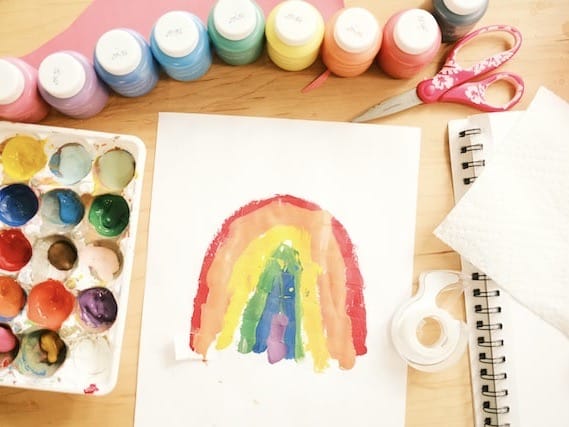
Between homeschooling materials, hobbies, pets, and daily activities, it’s easy to be overwhelmed by the number of things in your home. Setting up good home organization systems will help everyone in your house breathe a little easier.
Organizing for independence
As your child grows, they’ll need to learn how to find things independently. Storing books and toys on low, open shelves your child can reach encourages them to get things themselves. Accessible storage also makes it easy to teach your child how to put things back and clean up after themselves.
If you have toys or other learning materials in bins, label the containers with symbols or words to help develop reading skills. Encouraging independence gives your little one a boost of confidence.
Organizing for easy use
Bins, baskets, and containers make it easy for kids to keep track of blankets and toys. Storage bins should not have lids – your child should be able to reach in and get what they’re looking for.
Place books on low shelves, and set them up so your kids can see the entire front cover. While learning to read, they’re more likely to know what the book is by its cover art. Making book choices visible and easy to reach encourages kids to read more.
Organizing for learning
The same way you get more done at work with a clean desk, your child will learn better in a clean environment. Organization helps kids know where things belong. They’ll figure out that it’s less stressful to put something back in its spot than having to search for it later.
If your little one has many toys, store a few extra items in the closet or garage. Then, you can rotate the different toys and learning materials in and out with other things in your home. Rotating learning materials keeps things fresh and new, keeping your child engaged in the lessons.
Creating places to display kids’ work and successes
Displaying your child’s trophies, ribbons, and drawings encourages them and bolsters their confidence. Learn how to display your little one’s accomplishments in a way that doesn’t overwhelm or clutter up the rest of your home.
Benefits of displaying kids’ achievements
Whether it’s a great drawing or a soccer tournament trophy, displaying your child’s achievements positively affects their self-confidence. Put their drawings or quizzes on the fridge, and encourage your child to choose the work they want displayed. Displaying your child’s work also shows them you value what they do.
How to make the display appropriate for the child’s age
If your child is younger, hang up or his chore chart low on the fridge so they’ll notice you put it up. If you design a trophy case, keep things colorful and fun. Divide achievements by section and add decorations.
As your child grows up and starts playing sports or competing in chess tournaments, their trophies might be too large to add to a bookshelf. Make one wall in their room a trophy wall, with open shelves for smaller trophies and places to hang ribbons. Line up larger trophies on the floor so they’ll still be part of the display.
STEM activities for kids learning at home
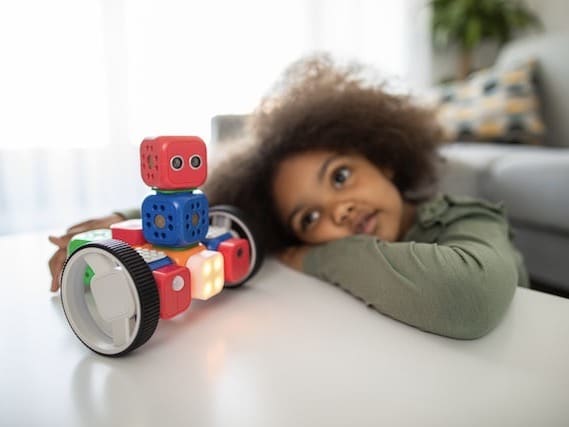
Science, technology, engineering, and mathematics are an essential part of any childhood education. Fun, simple STEM learning activities at home will inspire and motivate kids to study STEM subjects more closely.
Building a hand crank winch – Engineering
Building a simple winch helps foster engineering and problem-solving skills. You’ll need:
- 2 cardboard tubes
- A straw or pencil
- String
- Tape and scissors
- Small basket or another item to attach to the string
- A spool
Make two cuts at the top of each tube big enough for the straw or pencil to rest and spin. Set the cardboard tubes up and tape them to a flat surface to stay vertical.
Then, put your spool on the straw or pencil. Secure the spool with tape, and then tape your rope or string to the spool. Tie a basket or other item to the bottom of the string. When you turn the straw or pencil, the string gathers around the spool, pulling up the basket.
You can use recycled materials to introduce your kids to sustainability and environmentalism. Picking small toys or pieces of candy to pull up in the basket makes this engineering activity fun and keeps little ones interested.
Magnetic slime – Science
Making magnetic slime is a fun chemistry lesson and tactile activity. Kids will have many questions about how magnets work, so do a little research ahead of making the slime.
Magnetic slime only requires three ingredients: liquid starch, Elmer’s glue, and iron oxide powder. Iron oxide powder is available at craft supply stores or hardware stores. Mix a quarter cup of glue with two tablespoons of iron oxide powder and stir well. Then, pour a one-eighth cup of liquid starch and stir until everything is well mixed.
Your kids can knead the slime with their hands to bring it all together. When the slime is ready, bring out a magnet and watch the slime react.
Stop-motion animation video – Technology
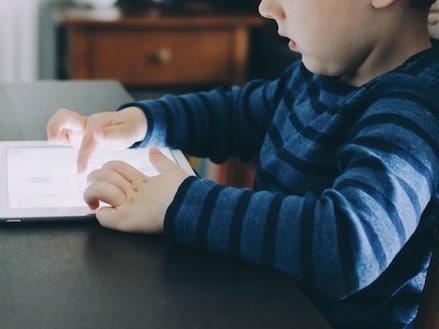
If you have a smartphone and a stop-motion app, get ready to say, “Action!” Making a stop-motion animation video helps your child learn about the science behind movie-making. You’ll also teach them about story-telling, art, and subjects that interest your child.
Stop-motion videos are made by placing an object in front of a camera and snapping a photo. You then move the object slightly and snap another photo. Once you have a few thousand pictures, play the sequence in rapid projection. The object seems to move smoothly across the screen.
Editing and creating the stop-motion video allows your child to use an iPad, smartphone, and editing software. Creating the backgrounds, props, and objects encourages creativity. Your kids can enjoy watching their short films when everything is said.
Creating a homeschooling schedule
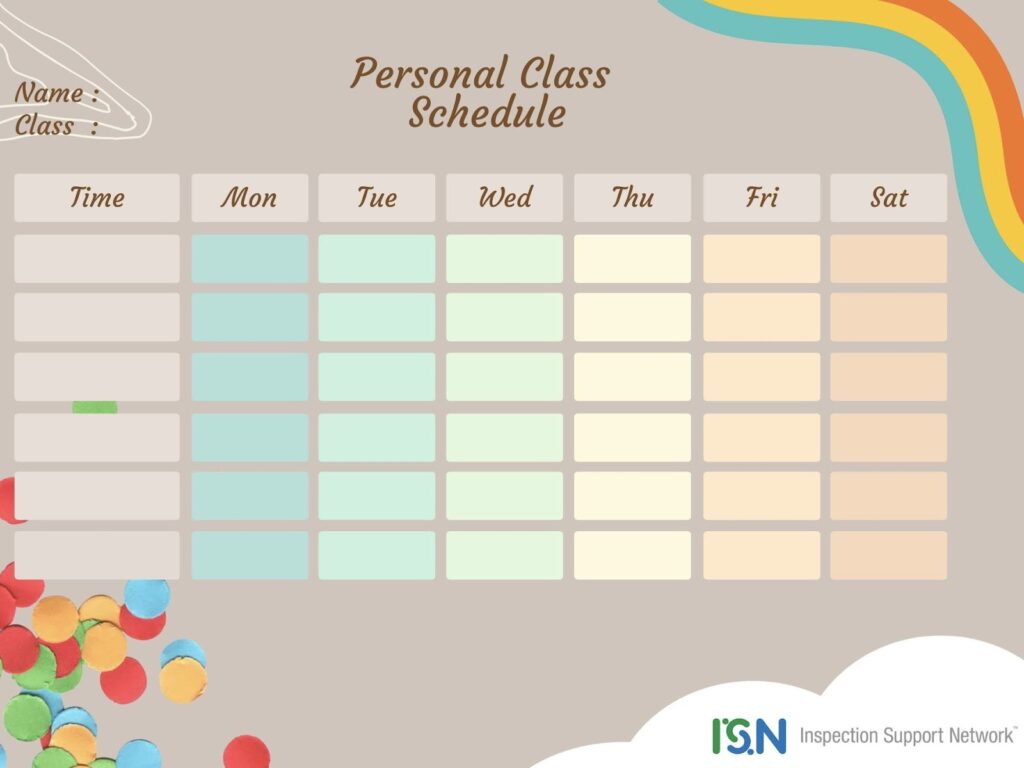
Planning a routine rather than a strict schedule gives you more flexibility throughout the week. Block out chunks of time for different activities, but don’t worry if things don’t go to plan. Follow your instincts, listen to your kids, and leave some room to go with the flow.
The best time to teach math
The best time to teach math is usually in the morning. Dedicate a chunk of time after breakfast for math worksheets and activities. Your child will be focused and ready to absorb the lesson. Math problems help wake up the brain, preparing your kids for other daily lessons.
The best time to do PE
If your child is an early riser, some physical activity first thing in the morning may help them wake up and burn off some excess energy so they can focus on their other lessons. Scheduling P.E. after naptime helps shake off grogginess, so your child is engaged and alert for the rest of the day.
Art classes – are they really necessary in your kids’ schedule?
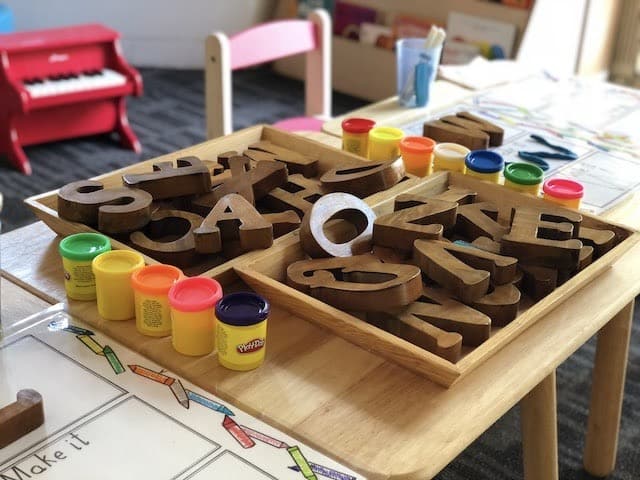
The short answer is yes. Art helps children understand colors and express their feelings. Writing poems, making pottery, and painting pictures all help engage your child’s imagination.
Making time for science and creative experiments
Small, safe science projects keep learning fun. Setting up the experiment and cleaning up will take more time than a spelling or reading lesson. You don’t have to go over every subject every day. Set aside a Friday afternoon to make a baking soda volcano so they have a fun project to look forward to at the end of the week.
Conclusion
Creating a great homeschooling environment takes time, planning, and flexibility. No matter what size your home is, there are fun, easy ways to help your little one focus and learn. Keep these tips and guidelines in mind, and you’ll have a great home learning environment that works for your kid and the whole family.

